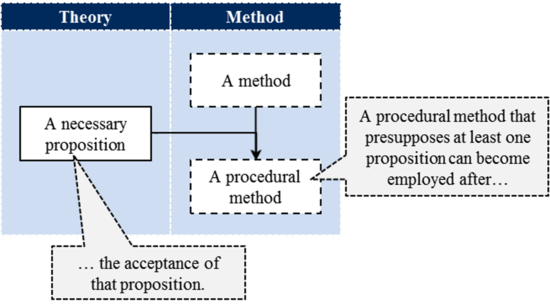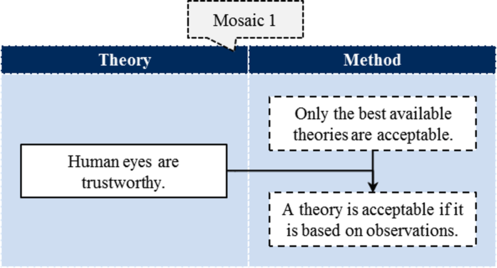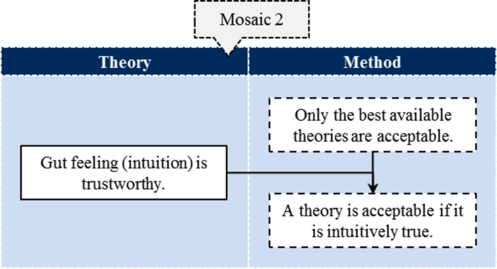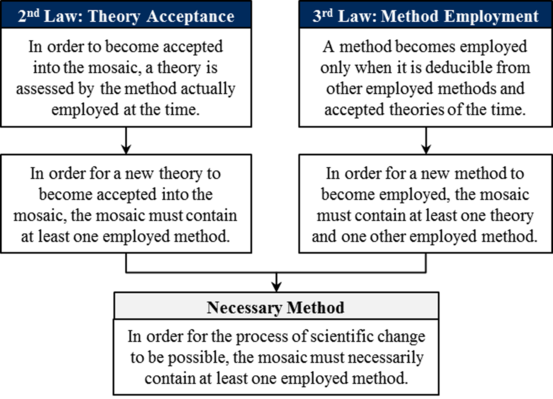Necessary Method theorem (Barseghyan-2015)
This is an answer to the question Necessary Methods that states "In order for the process of scientific change to be possible, the mosaic must necessarily contain at least one employed method."
Necessary Method theorem was formulated by Hakob Barseghyan in 2015.1 It is currently accepted by Scientonomy community as the best available answer to the question.
Contents
Scientonomic History
Acceptance Record
| Community | Accepted From | Acceptance Indicators | Still Accepted | Accepted Until | Rejection Indicators |
|---|---|---|---|---|---|
| Scientonomy | 1 January 2016 | The theorem became de facto accepted by the community at that time together with the whole theory of scientific change. | Yes |
Question Answered
Necessary Method theorem (Barseghyan-2015) is an attempt to answer the following question: Are there methods that are necessarily part of any mosaic? What methods, if any, are necessary for the process of scientific change to occur?
See Necessary Methods for more details.
Description
Given the nonempty mosaic theorem, it follows that there must be at least one element present in a mosaic. By the Second Law a theory can only be accepted into a mosaic if there is a method the community can use to appraise the theory. By the Third Law and methods become employed when they are deductive consequences of accepted theories. Thus, there must exist some proposition the form of a primitive dynamic substantive method in the nonempty mosaic with which a community can appraise new theories.
The gist of this theory can be illustrated by the following examples.
A necessary method cannot be substantive: Testability
The requirement of 'testability', according to which a scientific theory must be empirically testable, is often portrayed as "one of the prerequisites of science" though it is by no means a necessary element in any mosaic. Barseghyan (2015) develops the case study as follows:
The explanation is simple: the requirement of testability is substantive and, therefore, we can easily conceive of a mosaic where it is not present. It is substantive for it is based, among other things, on such a non-trivial assumption as “observations and experiments are a trustworthy source of knowledge about the world”. Thus, the requirement is not a necessarily a part of any mosaic; it can become employed after the acceptance of the assumptions on which it is based. The historical record confirms this conclusion. It is well known that testability hasn’t always been among the implicit requirements of the scientific community. For example, it played virtually no role in the Aristotelian-medieval mosaic.2p. 139 The same holds for any substantive method. For instance, the oft-cited requirement of repeatability of experiments is evidently part of our current mosaic, but not of every possible mosaic. Similarly, the requirement to avoid supernatural explanations is implicit in our contemporary mosaic, but it is not a necessary part of any mosaic.2p. 229
Hypothetical Community
To better illustrate this theorem, we can imagine a community with a set of accepted propositions.
Community φ accepts proposition α. For α to have become accepted, through the second law, we know that φ must have had implicit expectations which α satisfied. No matter what those expectations are, if the community had not harbored those expectations there could be no acceptance.
Similarly, if we have a community φ which experiences a change of expectations (i.e. a change of method), it is deductively true that φ already had a set of expectations which could be referred to as a method.Procedural methods that presuppose propositions are not necessary methods
To show why a necessary method must not presuppose any necessary propositions, we will consider a procedural method that does presuppose some necessary propositions:
Let it be the prescription that “if a proposition is deductively inferred from other accepted propositions, it must also be accepted”. As we know, this abstract method of deductive acceptance is procedural, as it is based on the definition of deductive logical inference.420 Now, it is obvious that this procedural method can become employed after the acceptance of the proposition on which it is based. Therefore, this procedural method is not necessarily part of any possible mosaic. The same applies to any procedural method that presupposes at least one necessary proposition. Such methods aren’t necessarily present in any mosaic, for they can be employed after the acceptance of the necessary propositions on which they are based.1pp. 229-230
Many different theories satisfy the abstract requirement
Most theories can satisfy the abstract requirement of the necessary method. Barseghyan (2015) outlines the following example:
Imagine a community with no initial beliefs whatsoever trying to learn something about the world. In other words, the only initial element of their mosaic is the abstract requirement to accept only the best available theories. Now, suppose they come up with all sorts of hypotheses about the world. Since their method is as inconclusive as it gets, chances are many of the hypotheses will simultaneously “meet their expectations”. In such circumstances, different parties will most likely end up accepting different theories, i.e. multiple mosaic splits are virtually inevitable. For example, while some may come to believe that our eyes are trustworthy, others may accept that intuitions (or gut feelings) are the only trustworthy source of knowledge. As a result, the two parties will employ different concrete methods (by the third law) and will end up with essentially different mosaics.1pp. 231-232
These examples are not altogether fictitious. It is possible that something along these lines happened in ancient Greece, where some schools of philosophy accepted that the senses are, by and large, trustworthy, while other schools held that the senses are unreliable and that the only source of certain knowledge is divine insight (intuition). Thus, the historical fact of the existence of diverse mosaics in the times of Plato and Aristotle shouldn’t come as a surprise. As a result, at early stages, multiple mosaic splits are quite likely.1pp. 233
Reasons
Reason: Deduction of the Necessary Method Theorem
Barseghyan's explanation of the deduction is as follows:1pp. 227-228
By the Non-Empty Mosaic theorem, any mosaic contains at least one element, which is either a theory or a method. But which one is it: is it a theory or is it a method? It is easy to see that if this necessary element of the mosaic were a theory, the process of scientific change would never begin in the first place. Suppose there is a community that accepts only one belief and employs no method whatsoever; this community has no expectations whatsoever. It is obvious that the mosaic of this community will never acquire another element. On the one hand, in order for new theories to become accepted into the mosaic, the mosaic must contain at least one method (by the second law). On the other hand, in order for the mosaic to acquire a new method, there must be not only accepted theories, but also at least one other employed method (by the third law). Indeed, if we recall the historical examples of the third law that we have discussed, we will see that new methods become employed when they are deductive consequences of accepted theories and at least one other employed method. Thus, the necessary (indispensable) element cannot be a theory – it must be a method.
This reason for Necessary Method theorem (Barseghyan-2015) was formulated by Hakob Barseghyan in 2015.1
If a reason supporting this theory is missing, please add it here.
Questions About This Theory
There are no higher-order questions concerning this theory.
If a question about this theory is missing, please add it here.




